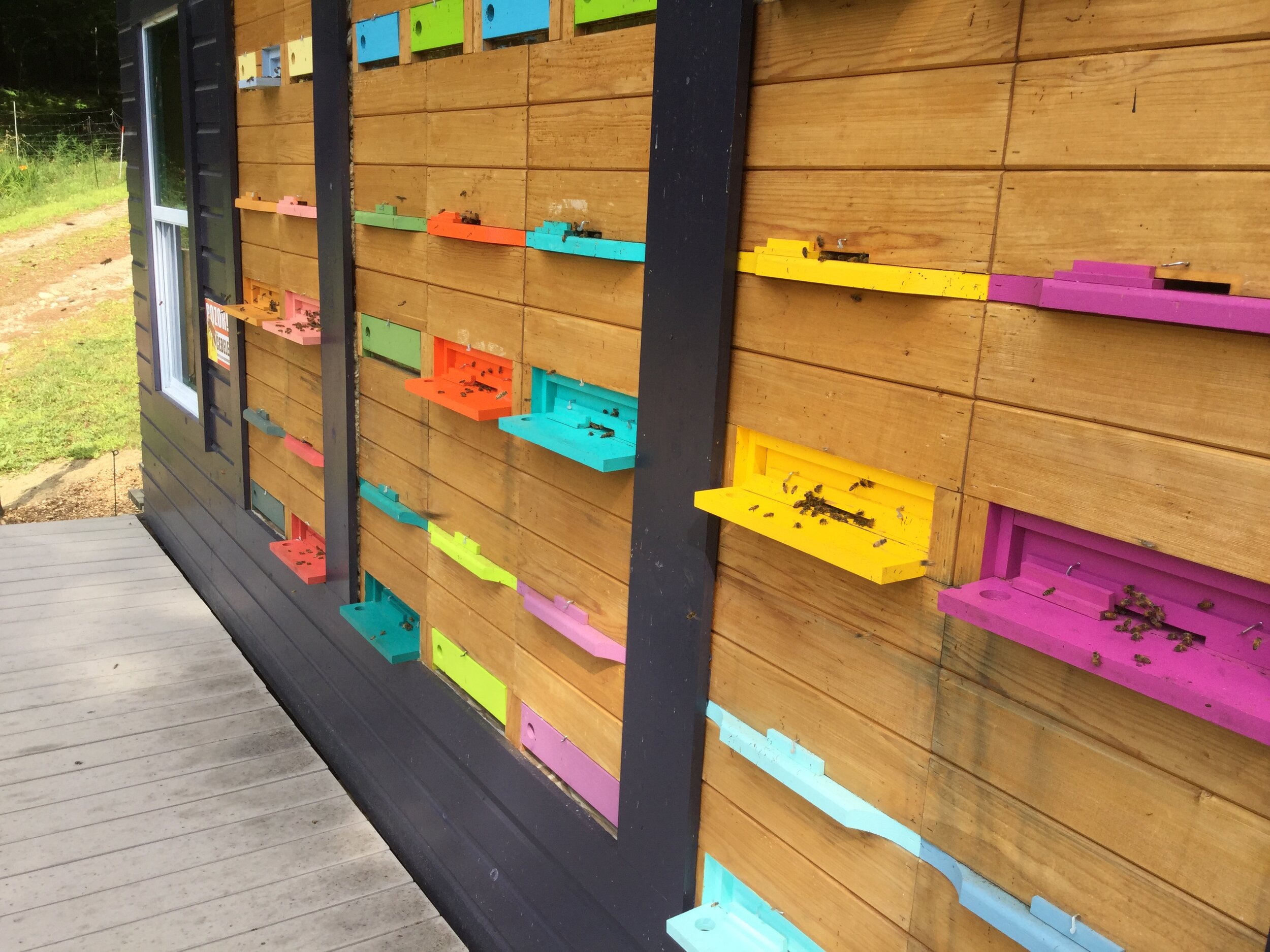Heathwing’s Slovenian beehouse and its surrounding garden.
The hives in a Slovenian bee house are referred to as AŽ hives, from the initials of Anton Žnideršic, who developed them in the late nineteenth century. They are designed to be housed in a structure which not only protects the bees from harsh weather, but also provides a pleasant spot for the beekeeper to work. The hives face south or southeast to receive the sun; the back of the hive is protected from the north winds by the house. Only the front of the hive where the bees enter and exit is exposed to the elements, so, unlike Langstroth hives, AŽ hives have very long lives. I have seen hives in Slovenia that are over fifty years old and still being worked.
The front of the hives where the bees enter and exit face south.
My hives, like most AŽ hives in Slovenia, are two level hives. Each hive’s landing board and upper and lower entrances are painted different colors to help the bee return to her hive. The remainder of the hive is stained. Because my bee house is built on a hill and the ground slopes downward, I built a four foot walkway in front, so I could access hive entrances when needed. It is not necessary to build a building from scratch to house your AŽ hives; mine is a former chicken coop. Note the before and after pictures below.
I have seen bee houses made from a window in a garage (just add a platform for the hives), old sheds, trailers, a discarded camper; a dilapidated lean-to was resurrected with a little TLC to be quite functional. The important thing is that the hives must be protected from the weather.
Beehouse interior. The two-level hives are numbered. The five and seven frame nucs are across the top, identified by letters.
The bees are worked from the back of the hives. Each hive has a door, like a cupboard, which when opened reveals the two levels of bees behind interior screen doors and separated by a queen excluder. The brood box is the lower level. The honey box is above the excluder.
The biggest advantage to AŽ hives is that the beekeeper never needs to lift anything heavier than an individual frame full of honey, a maximum weight of 6-8 pounds.
The disadvantage is that during swarm season, the beekeeper must be alert at all times to ensure there is room for the queen to lay and for the bees to stash nectar. This is done by shifting frames up and down, removing full frames of honey, or removing several frames altogether to a nuc hive creating an “artificial swarm,” in Langstroth’s words, or a split in modern lingo.
When extracting, I remove the rugs and lay down a tarp.
In my bee house, I planned several areas for storage of bee supplies: over the hives, under the hives, and under the work counter. It is efficient to have everything you need at your fingertips, no trudging back to a shed to get another hive body. The wall left of the counter has a deep sink, next to which I store my honey extractor, ready for use when needed.
Opposite the hives is a loveseat that opens into a bed and a counter for product display.
Insulating foam is in. The top vent is turned down and the bottom vent is turned up.
AŽ hives are easy to insulate for the winter. A piece of foam is inserted into the back of the hive, and the upper and lower flaps are left open for air circulation. Honey bees will produce as much as five gallons of water in respiration over the course of a winter. The moisture passes from the inside of the hive through the foam to dissipate outside of the hive. Sometimes there will be ice crystals on the outside of the foam, but on its other side, it is dry and toasty warm.
Hives with winter foam. Notice the smoker on the shelf - a length of pressed cardboard is all you need.
The pictures below show the conversion of my chicken coop my beehouse.
Chicken coop, the bee house to be. A trap door opened to the predator proof run below. Three far windows became the hive openings.
The new bee house’s walkway is in front of the hives.
Chicken coop interior. The window on the far wall became the hobbit door (you have to duck to go through it).
The bee walk extends into a deck.
The window became a door onto the bee deck. Note the clean-out door on the left for shoveling shavings into a garden cart.
The hobbit door opens out to the bee deck.
Purchasing nucs.
Heathwing Apiary sells both Slovenian and Langstroph nucs every Spring. Nucs consist of five drawn frames with bees and a laying queen. Contact us for availability.
If you are interested in learning more about Slovenian AŽ hives and bee houses, check out http://slovenianbeekeeping.com












